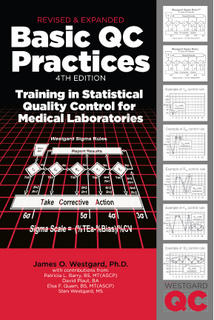
Basic QC Practices Online Course
Revised and Expanded course.
Accredited by the ASCLS for 15 PACE credits.
Once ordered, we will contact you to deliver your username and password. For immediate access, register and pay directly at the Westgard Course Portal
Note that this course is entirely online - there is nothing necessary to ship you for you to complete this course. You may prefer to purchase the Basic QC Practices manual, but this is entirely optional.
Basic QC Practices is our most popular online course. Hundreds of participants in all areas of healthcare have taken this course. Dozens of facilities, from diagnostic companies to laboratories to universities to military groups, have taken Basic QC Practices as individuals or as part of a larger site license.
Dr. James O. Westgard, Ph.D. is the course coordinator and primary instructor. Other instructors who contributed material to the course include Patricia L. Barry, BS, MT(ASCP) and Elsa F. Quam, BS, MT(ASCP), who are Quality Specialists in the Clinical Laboratories at the University of Wisconsin Hospital, and Sharon S. Ehrmeyer, PhD, MT(ASCP), who is CLS Program Director and Professor of Pathology and Laboratory Medicine at the University of Wisconsin Medical School.
Purpose
This course is intended to provide education and training in quality control (QC) to a broad audience of healthcare practicioners who perform laboratory tests in central laboratories, clinic or outpatient laboratories, and point-of-care settings.
The emphasis is on statistical QC because this is the backbone of any good laboratory QC program, regardless of the setting where the tests are being performed. Statistical QC is a widely applicable technique that is very powerful for detecting problems with test performance and very quantitative for demonstrating proficiency of analysts and operators, assuming the technique is properly implemented and the QC data is properly interpreted. This course should help healthcare practictioners implement and operate valid statistical QC procedures.
Course Goals
Participants who complete the lessons in this course will be able to:
- Access internet resources to support continuing education and training in analytical quality management.
- Assess individual needs for QC training and education on the basis of responsibilities for laboratory tests.
- State the basic idea of statistical QC in terms of the variation expected in a measurement process.
- Identify the regulatory and accreditation requirements for QC for tests of interest.
- Select control materials that are appropriate for tests of interest.
- Calculate monthly QC statistics (mean, standard deviation or SD, coefficient of variation or CV) and control limits, as well as cumulative statistics and cumulative control limits.
- Construct Levey-Jennings control charts with appropriate control limits, plot example control data, and interpret the control results.
- Recognize problems with false rejections caused by narrow control limits, such as commonly used 2 SD control limits.
- Interpret control results with a series of rules to determine if patient test results can be reported and, if not, what type of analytical errors are likely occurring in out-of-control runs.
- Distinguish between good and bad habits for responding to out-of-control problems.
- Specify the parameters and information needed to make QC records useful for trouble-shooting and problem-solving.
- Perform a critical review of laboratory practices for planning, establishing, and operating a QC procedure.
- Identify QC planning approaches that are practical in service laboratories.
Course materials
A course syllabus provides links to all the course lessons. Each course lesson provides a summary of that lesson, specific objectives, links to the course materials that are to be used, a list of things to do, and some questions for self- assessment.
Interactive Components
- Participants are encouraged to submit questions by e-mail. These questions will be summarized and a representative sample will be answered and posted.
- Several online QC tools allow participants to plot data on Levey-Jennings charts,
- Simulate QC data and its interpretation on Levey-Jennings charts, and more.
For more details about the Basic QC Practices course, visit the course description page at https://westgard.com/courses/guruprograms/3-course-catalog/3-basic-qc-practices.html
Taking this course for credit
Basic QC Practices is approved at the Intermediate Level of Instruction for 15 hours of PACE credit. Participants must pass a final exam to receive the 15 PACE credits. The internet materials are provided on the website of Westgard Quality Corporation. The PACE certificate will be issued by the ASCLS
